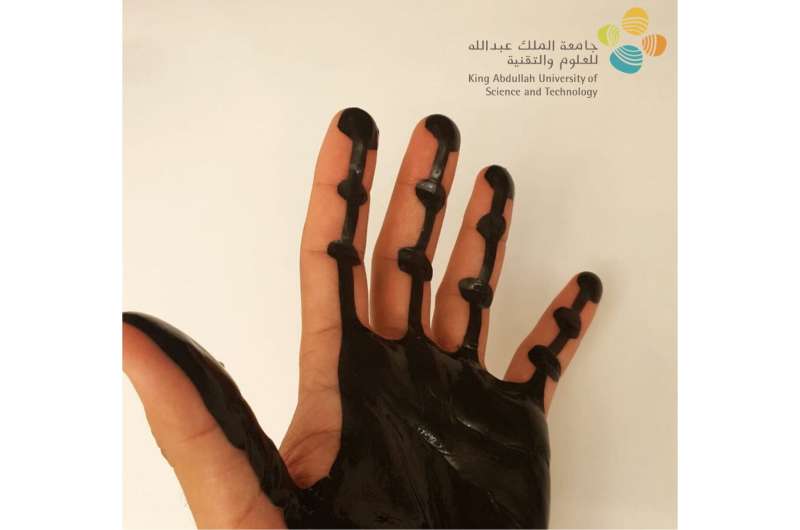Credit: Almansouri et al.
Researchers at King Abdullah University of Science and Technology have recently developed a flexible and imperceptible magnetic skin that adds permanent magnetic properties to all surfaces to which it is applied. This artificial skin, presented in a paper published in Wiley's Advanced Materials Technologies journal, could have numerous interesting applications. For instance, it could enable the development of more effective tools to aid people with disabilities, help biomedical professionals to monitor their patients' vital signs, and pave the way for new consumer tech.
"Artificial skins are all about extending our senses or abilities," Adbullah Almansouri, one of the researchers who carried out the study, told TechXplore. "A great challenge in their development, however, is that they should be imperceptible and comfortable to wear. This is very difficult to achieve reliably and durably, if we need stretchable electronics, batteries, substrates, antennas, sensors, wires, etc. We decided to remove all these delicate components from the skin itself and place them in a comfortable nearby location (i.e., inside of eye glasses or hidden in a fabric)."
The artificial skin, developed under the supervision of Prof. Jürgen Kosel, is magnetic, thin and highly flexible. When it is worn by a human user, it can be easily tracked by a nearby magnetic sensor. For instance, if a user wears it on his eyelid, it allows for his eye movements to be tracked; if worn on fingers, it can help to monitor a person's physiological responses or even to control switches without touching them.
"The magnetic skin we developed is made of an ultra-flexible, wearable magnetic material," Almansouri explained. "Its unique advantage is that it eliminates the need for any electronics on the skin itself, hence reducing the complexity arising from wires, on-chip batteries, antennas, etc. The magnetic skin can be used to perform relatively sophisticated applications, such as tracking physiological movements (i.e., tracking the eye movement by attaching the magnetic skin on the eyelid) or contact-free user-machine interfaces and device control."
Credit: Almansouri et al.
Most existing artificial skins require additional electronic components and elaborate micro-fabrication processes. In contrast, the magnetic skin developed by the researchers is easy to assemble, as it is made by mixing an elastomer matrix with magnetic powder and then drying this mixture at room temperature.
When this simple and effective fabrication process is complete, the material is magnetized with electro or permanent magnets, following a specific procedure that is tailored around its intended application. The system is then finalized by integrating a simple, off-the-shelf magnetic sensor.
"Another feature of the magnetic skin is that it can be fabricated in any shape or color, which means it could be shaped and colored like your favorite Emoji, a company or research team's logo, etc.," Almansouri added.
The artificial skin developed by Almansouri and his colleagues is lightweight, yet it maintains a magnetization of up to 360 mT. Due to its simple design and fabrication process, it eliminates the need for electronics, batteries and other components.
Credit: Almansouri et al.
As it does not require any wiring or other integrated hardware, the material is very easy to implement and use. According to the researchers, just a few minutes of basic training should allow any user, even someone with a basic knowledge of the technology, to start his/her own artificial skin project.
"We are hoping that our magnetic skin will help to realize practical solutions that can improve the quality of many lives," Almansouri said. "A user survey we carried out confirmed that the magnetic skin can be comfortably worn and this opens the door for delicate measurements like the movement of the eye."
The biocompatible and imperceptible material enables the development of a wide variety of useful and innovative tools, both for monitoring physiological responses and for remote gesture control. One of its most impactful implementations would be as an integration for new technologies to assist people with disabilities. For instance, combining the magnetic skin with smart home applications would allow physically disabled individuals to carry out actions (e.g., switch on the lights, turn on the washing machine, etc.) remotely.
"We believe that this imperceptible magnetic skin has a great potential to improve the quality of our life," Prof. Kosel said. "For example, it could enable the development of comfortable methods for tracking sleep quality and eye movement, which is of interest in sleep laboratories or to monitor eye diseases, magnetic hands for virtual reality and augmented reality applications, magnetic gloves for contact-free switching and control in sterile environments, and to track vital signs in biomedical applications."
More information: Abdullah S. Almansouri et al. An Imperceptible Magnetic Skin, Advanced Materials Technologies (2019). DOI: 10.1002/admt.201900493
© 2019 Science X Network

























